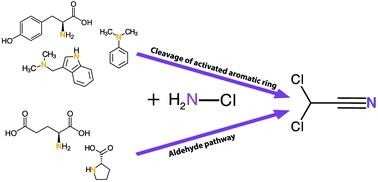当前位置:
X-MOL 学术
›
Environ. Sci.: Processes Impacts
›
论文详情
Our official English website, www.x-mol.net, welcomes your
feedback! (Note: you will need to create a separate account there.)
Halogenated semivolatile acetonitriles as chloramination disinfection by-products in water treatment: a new formation pathway from activated aromatic compounds.
Environmental Science: Processes & Impacts ( IF 4.3 ) Pub Date : 2020-02-28 , DOI: 10.1039/c9em00603f Kathryn L Linge 1 , Ina Kristiana , Deborah Liew , Adam Holman , Cynthia A Joll
Environmental Science: Processes & Impacts ( IF 4.3 ) Pub Date : 2020-02-28 , DOI: 10.1039/c9em00603f Kathryn L Linge 1 , Ina Kristiana , Deborah Liew , Adam Holman , Cynthia A Joll
Affiliation

|
The use of monochloramine as an alternative disinfectant to chlorine in drinking water treatment can lead to increased formation of emerging nitrogenous halogenated disinfection by-products (DBPs), even when the formation of regulated halogenated DBPs has decreased. In this study, we investigated formation of the semivolatile haloacetonitriles (HANs) from model nitrogen-containing compounds (6 amines, 1 amide, 6 amino acids, and 2 nitrogen-containing aromatic chemicals) and natural organic matter (NOM) reference materials after chloramination. In agreement with previous studies, most amino acids formed dichloroacetonitrile (DCAN). Additionally, DCAN formed from two amines containing aromatic rings (N,N-dimethylaniline and 3-(dimethylamino-methyl)indole) and the two nitrogen-containing aromatic chemicals (cotinine and phenytoin). This is the first report of DCAN formation from these precursors. DCAN also formed after chloramination of NOM reference materials, with the highest formation from the NOM material with the highest aromaticity. The results provide new evidence of a DCAN formation pathway from cleavage of activated aromatic structures after electrophilic substitution of chlorine and addition of monochloramine to the ring system. In particular, the results suggest that the previously proposed aldehyde pathway from the amino acid group is not responsible for the majority of DCAN formation from amino acids with an activated aromatic ring system. This newly proposed formation pathway for DCAN from activated aromatic organic matter has significant implications for NOM removal during water treatment to minimise DBP formation. Studies using 15N-labelled monochloramine showed that there was significant incorporation of nitrogen from monochloramine into DCAN, demonstrating that monochloramine disinfection promotes the formation of HANs.
中文翻译:

卤化半挥发性乙腈作为水处理中的氯化消毒副产物:由活化的芳族化合物形成的新途径。
在饮用水处理中使用一氯胺作为氯的替代消毒剂可导致形成的含氮卤代消毒副产物(DBP)的形成增加,即使减少了受控卤代DBP的形成。在这项研究中,我们研究了氯化后由模型含氮化合物(6种胺,1个酰胺,6个氨基酸和2种含氮芳族化学品)和天然有机物质(NOM)参考材料形成的半挥发性卤乙腈(HANs) 。与先前的研究一致,大多数氨基酸形成了二氯乙腈(DCAN)。此外,DCAN是由两种含有芳环的胺形成的(N,N-二甲基苯胺和3-(二甲基氨基-甲基)吲哚)和两种含氮芳香族化学物质(可替宁和苯妥英)。这是由这些前体形成DCAN的第一份报告。在NOM参考物质经过氯化处理后,也形成了DCAN,其中形成率最高的NOM材料具有最高的芳香性。该结果提供了DCAN形成途径的新证据,该亲和力是在氯的亲电取代后,将单氯胺添加到环系统后,裂解的活化芳族结构。特别地,结果表明,先前提出的来自氨基酸基团的醛途径不负责由具有活化的芳族环系统的氨基酸形成的大多数DCAN。这个新提出的由活化的芳香族有机物形成DCAN的形成途径,对水处理过程中NOM的去除具有重要意义,以最大程度地减少DBP的形成。研究使用15 N标记的一氯胺表明,单氯胺中的氮大量掺入DCAN中,表明一氯胺消毒可促进HAN的形成。
更新日期:2020-02-28
中文翻译:

卤化半挥发性乙腈作为水处理中的氯化消毒副产物:由活化的芳族化合物形成的新途径。
在饮用水处理中使用一氯胺作为氯的替代消毒剂可导致形成的含氮卤代消毒副产物(DBP)的形成增加,即使减少了受控卤代DBP的形成。在这项研究中,我们研究了氯化后由模型含氮化合物(6种胺,1个酰胺,6个氨基酸和2种含氮芳族化学品)和天然有机物质(NOM)参考材料形成的半挥发性卤乙腈(HANs) 。与先前的研究一致,大多数氨基酸形成了二氯乙腈(DCAN)。此外,DCAN是由两种含有芳环的胺形成的(N,N-二甲基苯胺和3-(二甲基氨基-甲基)吲哚)和两种含氮芳香族化学物质(可替宁和苯妥英)。这是由这些前体形成DCAN的第一份报告。在NOM参考物质经过氯化处理后,也形成了DCAN,其中形成率最高的NOM材料具有最高的芳香性。该结果提供了DCAN形成途径的新证据,该亲和力是在氯的亲电取代后,将单氯胺添加到环系统后,裂解的活化芳族结构。特别地,结果表明,先前提出的来自氨基酸基团的醛途径不负责由具有活化的芳族环系统的氨基酸形成的大多数DCAN。这个新提出的由活化的芳香族有机物形成DCAN的形成途径,对水处理过程中NOM的去除具有重要意义,以最大程度地减少DBP的形成。研究使用15 N标记的一氯胺表明,单氯胺中的氮大量掺入DCAN中,表明一氯胺消毒可促进HAN的形成。











































 京公网安备 11010802027423号
京公网安备 11010802027423号